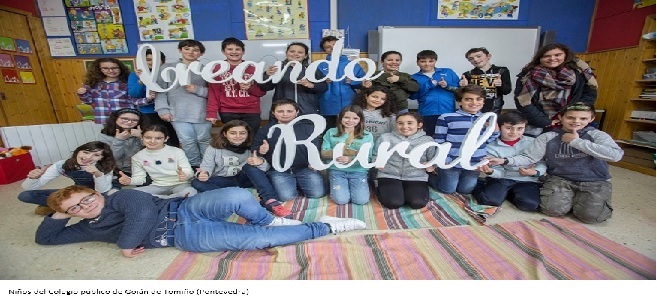
08 de November de 2019
For children, experiencing the rural environment in which they live is a discovery and a joy. It's the best way for them to develop a love for their land and a desire to preserve it. According to Eva Gil, a technician with the Galicia Southwest Rural Development Association, "the most exciting thing is going into schools and seeing that the children are proud to live in rural areas."
In 2018, this local action group launched a competition for preschool and primary school students in southeastern Pontevedra. The competition, called "Creating Rural," was designed to complement formal educational programs, which are more general and do not focus on specific regions. Its primary objective is to educate the public about the importance of preserving rural identity and engaging children with their surroundings.
To this end, they organized this competition for schoolchildren between the ages of 3 and 12 and managed to involve 13 city councils and 28 classrooms from 13 schools in seven municipalities, both public and private. The result was so successful that a second edition was held this year, and they will be celebrating a third in 2020. "We decided to launch these educational units to instill in our children a sense of belonging to their own environments so that they can establish connections through knowledge and affection," explains geographer Eva Gil, the project leader.
In addition to the success of schoolchildren's participation, the quality of the projects and the enormous response from the popular vote must be added. In total, approximately 8,000 people voted in the two editions of the competition, residents of the municipalities of Baiona, Fornelos de Montes, Gondomar, A Guarda, Mos, Nigrán, Oia, Pazos de Borbén, O Porriño, Redondela, O Rosal, Tomiño, and Tui. The investment over these two years has amounted to approximately 32,400 euros and has been funded by the Leader program for "Promoting and stimulating local development."
The winners in the children's category were given a day trip to a farm school that receives Leader grants. For the primary school winners, the trip was to the "Fervenzaventura" nature activity center, also a beneficiary of Leader grants in Galicia.
At the start of this project, "EU Rural" carried out an awareness and information campaign in schools and through the media to publicize the contest among the population. They set up a website, www.creandorural.org , which served as a means of dissemination throughout the contest and, in turn, to channel the popular vote. The ultimate goal was for students to learn about their cultural, landscape, and biodiversity heritage, to recover their traditions, to understand what sustainable development means, and to participate in the future of their environment. For Eva Gil, the most important thing is that "the children feel committed to their region to stimulate population settlement, rejuvenate the towns, and combat depopulation." She continues: "When we arrived at the schools, the children welcomed us as if we were celebrities, because we were the ones from Creating Rural. The most gratifying thing is seeing the little ones' faces and feeling their joy when they participate."
“EU Rural” was based on the “Participatory Local Development Strategy” they conducted in 2016 with Leader funds. In this study, they analyzed and delved into the social reality of the inhabitants of southwest Galicia. In Gil's opinion, “Rural children are our future, and we need them to understand the environment they live in so they can protect, preserve, and develop it.”
For the National Rural Network, "Creating Rural" is a clear example of a job well done because it is successfully raising awareness among children about the value of being part of rural society and the benefits of living surrounded by nature. As one of the second-grade children at the Serra de Vincios Primary School in Gondomar says, "We want to take advantage of the balance between humans and plants." Educating in positive values, generating rural pride, and offering viable and fair alternatives is the best way to keep rural areas alive.











